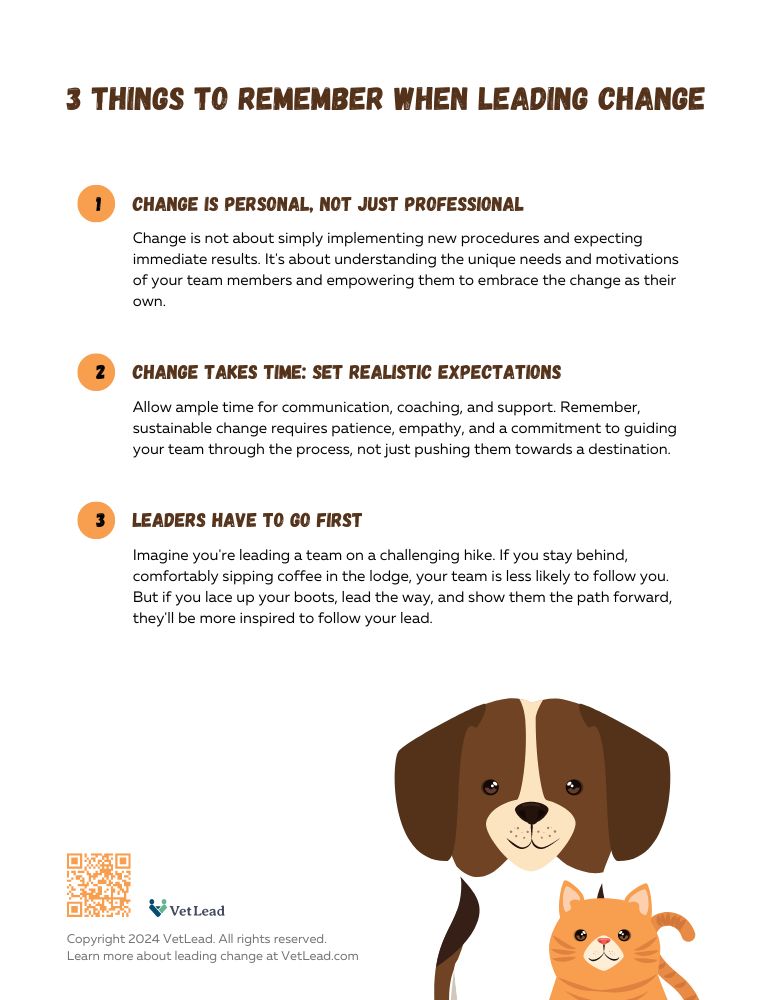In my work with veterinary practices, I've found that change is a constant companion on the road to success. Whether it's adapting to new technology, evolving client expectations, or shifts in the veterinary landscape, the ability to navigate change effectively is crucial for long-term growth.
But here's the thing: Simply managing change isn't enough. To truly thrive, you need to lead change. Managing change often focuses on the mechanics – sending out announcements, tweaking processes, and completing checklists. While these tasks are important, they can fall flat if the hearts and minds of your team aren't engaged.
Leading Change in Your Veterinary Hospital
Leading change, on the other hand, is about inspiring your team to embrace a new vision, empowering them to participate in the process, and creating a culture that thrives on innovation and adaptability. It's about recognizing that change isn't just a series of tasks to be checked off; it's a journey that requires a shift in mindset, behaviors, and ultimately, culture.

We can start by helping veterinary leaders shift their perspective from managing change to leading it. This involves recognizing that change isn't solely about processes and procedures; it's about people. If your team doesn't change, your practice won't either.
Here are three lessons that many veterinary practices overlook when working to create an adaptable, future-ready organization:
1
Change is Personal, Not Just Professional
Change often feels mechanical or methodical because it happens within an organization. But for change to truly succeed, it needs to resonate on a personal level for each team member. It requires individuals to shift their behaviors, mindsets, and habits—a challenge that can be overcome with the right focus on culture, coaching, and personalized goals.
Remember, change is not about simply implementing new procedures and expecting immediate results. It's about understanding the unique needs and motivations of your team members and empowering them to embrace the change as their own.
2
Change Takes Time: Set Realistic Expectations
Most practices experience an initial burst of enthusiasm when implementing change. However, when faced with inevitable challenges like resistance and setbacks, leaders can become frustrated and resort to forceful tactics. This can backfire, slowing down progress and alienating team members.
Instead, set realistic expectations from the start. Allow ample time for communication, coaching, and support. Remember, sustainable change requires patience, empathy, and a commitment to guiding your team through the process, not just pushing them towards a destination.
3
Leaders Have to Go First
Change starts at the top. If you expect your team to embrace new behaviors while clinging to your old ways, don't expect much progress. Leading by example is the most powerful way to inspire change. When you demonstrate adaptability, openness, and a willingness to learn, you set the tone for the entire practice.
Think of it this way: Imagine you're leading a team on a challenging hike. If you stay behind, comfortably sipping coffee in the lodge, your team is less likely to follow you. But if you lace up your boots, lead the way, and show them the path forward, they'll be more inspired to follow your lead.

Download this PDF Now
Share it with leaders and teams. No email address required.
Leading Change Doesn’t Have to Be a Struggle
Many veterinary practices excel at the mechanics of change: crafting communications, designing posters, sending emails, and issuing instructions. However, they often underestimate the human element. True change is a deeply personal journey, and it requires more than simply telling people what to do.
To drive lasting change, you must engage your team in a way that empowers them to become leaders of the change themselves. Simply pointing to a new destination won't automatically motivate your team to follow, even if you hold the power of the paycheck. While we might wish it were different, human behavior isn't a simple formula. It's a complex tapestry of emotions, motivations, and individual needs.
Master the Art of Change in Your Practice
So, we're far better off investing our energy in learning how to lead change effectively, rather than clinging to the hope that human behavior will suddenly become predictable and easily manipulated. The reality is that most organizations, including your competitors, struggle to navigate the complexities of change. By mastering the art of leading change, you gain an invaluable competitive advantage—a team that's engaged, adaptable, and ready to embrace the future.
Ready to lead your team toward a brighter future? Learn more about VetLead's membership and start your 7-day free trial today!
Has lasting change felt elusive in your practice? Share your story in the comments below.
